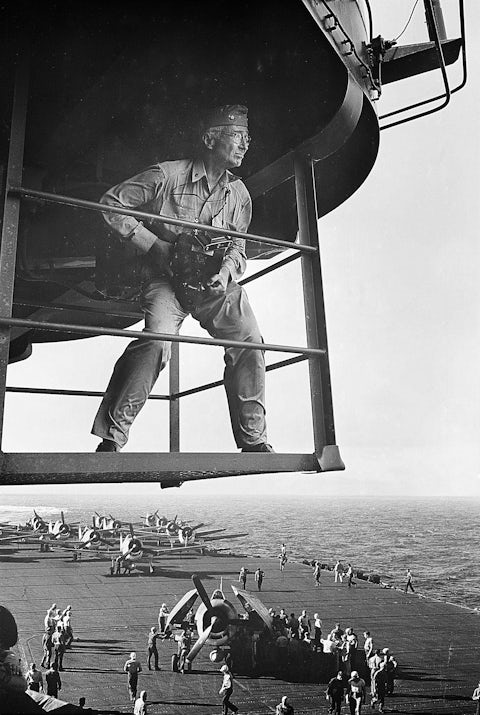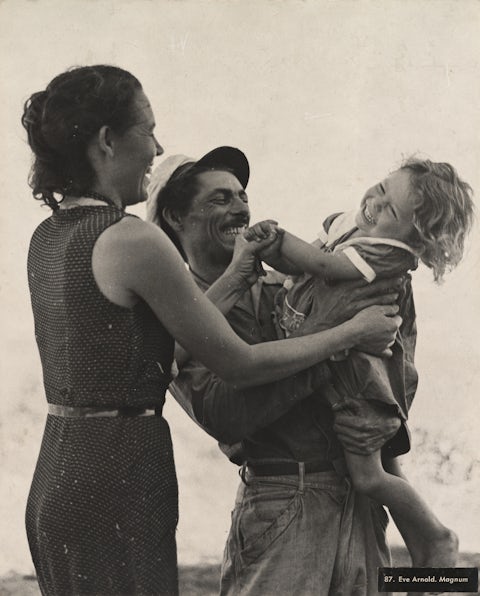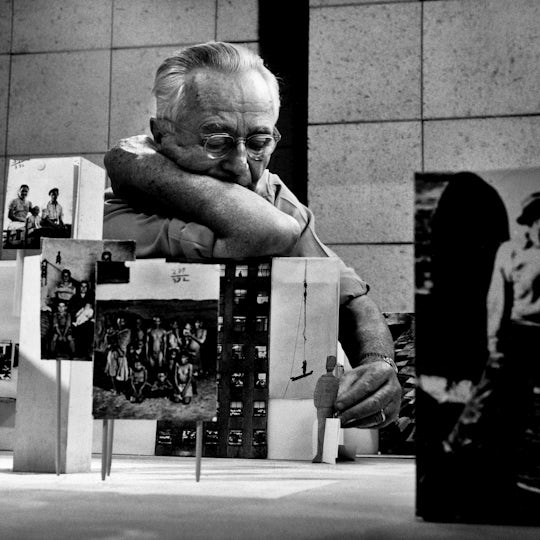Inspirations and mishaps: from experience to rejection of war
The Family of Man is strongly linked to Steichen’s personal evolution, to his experiences during the war, the context of the 1950s and his nomination as Director of MoMA’s Department of photography in 1947.
During the Second World War he formed the US Navy’s photographic division, then was nominated as the Director of the Naval Aviation Photographic Unit. He continued his artistic work through the lens of war and organised the exhibitions Road to Victory and Power in the Pacific. He also directed the documentary The Fighting Lady which received the Academy Award for Best Documentary in 1945.

Installation view of the exhibition 'Road to Victory', MoMA, NY, May 21 - October 4, 1942. © 2021. Digital image, The Museum of Modern Art, New York/Scala,
Florence

Victor Jorgensen, Commander Aboard USS Lexington. Commander Edward Steichen stands on a platform overlooking the deck of the USS Lexington. Propellor airplanes are on the deck, 1943 © CORBIS/Corbis via Getty Images
The MoMa
Founded in 1929, the Museum of Modern Art in New York is renowned nowadays as one of the largest and the most influential museums of the world.
Its collections offer an overview of any forms of art and it has had -and always has- the mission to promote and expose avant-garde pieces in order to highlight the work of modern or contemporary artists, even still unknown. A very modern institution from the very beginning, since it had always been collecting photographic artworks, it was already a major place for photographs of the 20th century when Steichen arrived. And yet his nomination as Director of MoMA’s department of photography was controversial. Influenced by his experiences in the military and commercial fields, Steichen didn’t only consider photography as an art form but also as a vector for communication.
In 1947 Steichen realised for the MoMA the exhibition Korea -The Impact of War which didn’t get the reactions he was expecting. His failed experience marked him deeply and influenced his decision to create The Family of Man:
"The Family of Man" was the most important undertaking of my career. In a way it had its genesis in the several war exhibitions I had organized. People flocked in great numbers to see it. They found some pictures revolting, some deeply moving. There even were tears shed, but that was as far as it went. They left the exhibition and promptly forgot it. Although I had presented war in all its grimness in three exhibitions, I had failed to accomplish my mission. I had not incited people into taking open and united action against war itself. This failure made me take stock of my fundamental idea. What was wrong? I came to the conclusion that I had been working from a negative approach, that what was needed was a positive statement on what a wonderful thing life was, how marvelous people were and, above all, how alike people were in all parts of the world.
The origins of the exhibition: approach, research and implementation
It was in this context, rich from his experiences of war, the influence of photojournalism, with an aspiration to the monumental and above all the willingness to make people react, that the project The Family of Man took shape for the MoMA.

Eve Arnold, Fisherman and family. Island girl, Bahia Honda, Cuba, 1954 © Magnum

Nat Farbman, Children playing wild and unrestrained games on sand dunes, Botswana, 1947, Time & Life © Getty Images

David Duncan, Man - mountains - his flock and sky … all are one, Quashqhai, Iran, 1946, Harry Ransom Center The University of Texas at Austin
After 1951 Steichen, assisted by the photographer Wayne Miller and his friend Dorothea Lange, began to look for photographs about “everydayness” that he described as an illustration of “the beauty of things in our lives”. In order to collect images, he published advertisements to seek contributions and analysed the archives from magazines such as Magnum Photos or Time & LIFE to get mostly contemporary documentary photographs. He also involved artists such as Henri Cartier-Bresson, one of the first to be informed of his ambition.
[…] a great photographic exhibition we are going to display here and all through Europe. The main theme will be the family of man… I do think that you will be interested in this project and I am looking forward to hearing your ideas and your advice about it.
Edward Steichen to Henri Cartier-Bresson, 1952
More than 4 years of preparatory work, from 4 to 7 million of photographs reviewed, everything was made to ensure the success of this large-scale project, one of the most important cultural projects, with both an artistic and documentary resonance around the same idea.

Homer Page, Preparations for "The Family of Man" © Homer Page Archive

Homer Page, Preparations for "The Family of Man" © Homer Page Archive
We were receiving contributions from all over the world, mailbags that were about one meter by half a meter. For several months we received several bags that size every day.
Wayne Miller
Finally, it was not less than 503 black and white photographs made by 273 photographers in 68 countries that were kept to bring this manifesto for peace and equality between man to life.
The apartment above the nightclub
When after years of reflection to mature the idea of the exhibition The Family of Man, Steichen embarked on the adventure, he didn’t give up in front of the task’s scale to achieve. He and his team selected 10,000 photos out of the 4 million they had to examine. Which was still too many for their office at the MoMA and they quickly found themselves overwhelmed. LIFE Magazine wrote thereupon a delightful anecdote: In front of the challenge, Steichen and Miller decided to rent an apartment in New York, right above a nightclub, and locked themselves. There they worked day and night, to the beat of the bass from the lower floor and studied one after the other each shot in order to build little by little their future exhibition. After 20 long weeks of hard work, everything was ready, at last. Steichen was 75 years old and had met his crazy challenge. He had reached the culmination of a life-long dream dedicated to his vision of photography. So, he went downstairs and there, on the pavement, he began dancing a jig under the incredulous eye of passers-by.
Among these images, great names of photography revealed their vision of man: Robert Capa, Henri Cartier-Bresson, Dorothea Lange, Robert Doisneau, August Sander, Ansel Adams, Willy Ronis, W. Eugene Smith, Eugene Harris…
The exhibition The Family of Man and its sources of inspiration cannot be separated from Steichen’s life. The exhibition should thus be perceived as the sum of both professional and personal experiences of its creator, from his family influences to the scars of war, from painting to exhibitions, from photographs of objects to portraits, from advertisement to art, from the individual to the collective, and so many other dimensions that a life devoted to experimentation would never stop exploring and reconciling.
A lesson of tolerance
Steichen had been familiar with the idea of equality between all since early childhood. It had been handed down to him by his education even before he developed his artistic vision. Indeed, as he told: “Once, when I was 10 years old, I came home from school, and as I was entering the door of her millinery shop I turned back and shouted into the street, ‘You dirty little kike!’ My mother called me over to the counter where she was serving customers and asked me what it was that I had called out. With innocent frankness, I repeated the insulting remark. She requested the customers to excuse her, locked the door of the shop and took me upstairs to our apartment. There, she talked to me quietly and earnestly for a long, long time, explaining that all people were alike regardless of race, creed, or color. She talked about the evils of bigotry and intolerance. This was possibly the most important single moment in my growth toward manhood, and it was certainly on that day the seed was sown that, 66 years later, grew into an exhibition called The Family of Man.”

Edward Steichen, My Mother, 1925 © 2021 The Estate of Edward Steichen / Artists Rights Society (ARS), New York

Dmitri Kessel, Aerial view of the Yangtze River Gorge shrouded in mist with river winding through steep rocky hills, Szechwan, China, 1946, Time & Life © Getty Images
